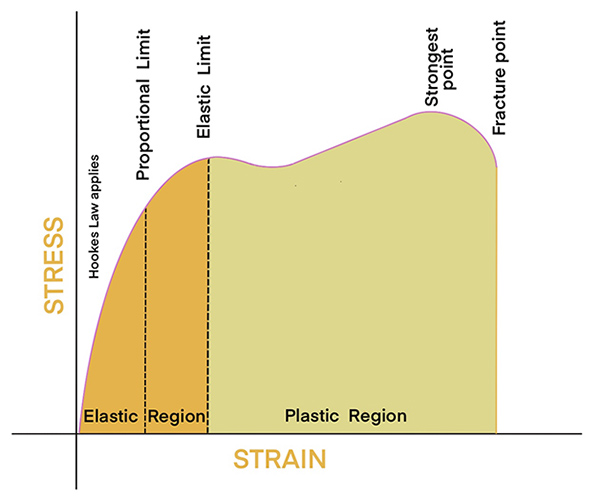Plasticity in construction
The term 'plasticity' refers to the degree to which as material has the characteristic of being easily shaped, moulded or formed. More specifically in terms of material science and building physics it relates to the terms plastic region and plastic deformation - where a material is unable to retain elasticity (return to its original shape), or as such has the ability to undergo permanent deformation in response to forces being applied. It is the middle stage of the characteristic behaviour of materials under stress and strain from forces being applied, the first stage being elasticity and the last stage being fracture or failure.
It is important to note that plasticity refers to a materials characteristics rather than being a reference to a particular type of material, such as plastic.
For example, natural clay has the characteristic of plasticity because it can be moulded into any shape, but also wood can have the characteristic of plasticity, where timber beams for example over years become permanently bowed but retain their strength and do not reach fracture point.
Plastics may also posses plasticity as a characteristic when they are heated and moulded into for example building components.
The level that a material can sustain plastic deformation under tensile force is referred to as ductility, whilst a material's ability to deform plastically without failing under compressive stresses is referred to as malleability.
A material that has a very small plastic region and potentially elastic region also is referred to as brittle.
[edit] Related articles on Designing Buildings
Featured articles and news
Government consultations for the summer of 2025
A year of Labour, past and present consultations on the environment, the built environment, training and tax.
CMA competitiveness probe of major housing developers
100 million affordable housing contributions committed with further consultation published.
Homes England supports Greencore Homes
42 new build affordable sustainable homes in Oxfordshire.
Zero carbon social housing: unlocking brownfield potential
Seven ZEDpod strategies for brownfield housing success.
CIOB report; a blueprint for SDGs and the built environment
Pairing the Sustainable Development Goals with projects.
Types, tests, standards and fires relating to external cladding
Brief descriptions with an extensive list of fires for review.
Latest Build UK Building Safety Regime explainer published
Key elements in one short, now updated document.
UKGBC launch the UK Climate Resilience Roadmap
First guidance of its kind on direct climate impacts for the built environment and how it can adapt.
CLC Health, Safety and Wellbeing Strategy 2025
Launched by the Minister for Industry to look at fatalities on site, improving mental health and other issues.
One of the most impressive Victorian architects. Book review.
Common Assessment Standard now with building safety
New CAS update now includes mandatory building safety questions.
RTPI leader to become new CIOB Chief Executive Officer
Dr Victoria Hills MRTPI, FICE to take over after Caroline Gumble’s departure.
Social and affordable housing, a long term plan for delivery
The “Delivering a Decade of Renewal for Social and Affordable Housing” strategy sets out future path.
A change to adoptive architecture
Effects of global weather warming on architectural detailing, material choice and human interaction.
The proposed publicly owned and backed subsidiary of Homes England, to facilitate new homes.
How big is the problem and what can we do to mitigate the effects?
Overheating guidance and tools for building designers
A number of cool guides to help with the heat.
The UK's Modern Industrial Strategy: A 10 year plan
Previous consultation criticism, current key elements and general support with some persisting reservations.
Building Safety Regulator reforms
New roles, new staff and a new fast track service pave the way for a single construction regulator.


























Comments
[edit] To make a comment about this article, or to suggest changes, click 'Add a comment' above. Separate your comments from any existing comments by inserting a horizontal line.